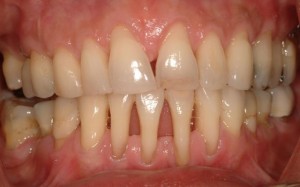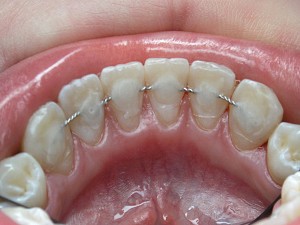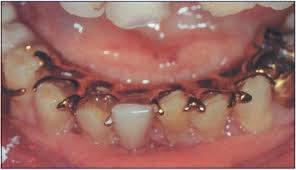Dental prosthetics for periodontal disease

Periodontal disease is a disease in which atrophy of the bone tissue of the jaw occurs, which can lead to complete loss of teeth.
In the late stages of the disease, periodontal disease is not curable and requires the adoption of drastic measures to restore the dentition.
One of the effective methods of tooth restoration is splinting.
Dental prosthetics during periodontal disease by splinting allows you to fix loose teeth, and also distribute the masticatory load in such a way as to exclude the necessary teeth from the act of chewing.
Prosthetics with permanent dental structures (dental bridge) during periodontal disease is not possible, because the prosthesis should be supported by two live and healthy teeth.
If the design is fixed to movable teeth, the prosthesis will be unstable, and the abutment teeth will break.
In this regard, the only option for prosthetics during periodontal disease is the installation of removable structures.
At the same time, removable clasp dentures with metal clasps allow you to fix weakly movable teeth.
Goals
- An exception to the process of chewing a certain group of teeth.
- Fixation of mobile teeth.
- Correct distribution of chewing load on teeth.
- Restoring the functionality of the dentition.
Ways to eliminate mobility

- Splinting by splinting on the inside of the teeth in a row.
- Installation of clasp construction with multi-link clasps and occlusal overlays. Such designs contribute to the distribution of chewing load not on the gums, but on the teeth. They also allow for unhindered therapeutic treatment, as when fixing the prosthesis, the gingival margin remains free.
- Extraction of badly loose teeth.
- Carrying out basal dental implantation. It allows you to install implants even with a minimal amount of bone tissue.
Features of prosthetics
- An increase in the total duration of dental prosthetics due to the need for periodontal treatment.
- The inability to restore a highly mobile tooth. With severe loosening, the affected tooth must be removed.
- Dental prosthetics during periodontal disease by implantation is not a contraindication.
Video: “Splinting teeth”
Criteria for choosing a prosthetics method
The choice of prosthetics method should be very careful and careful, as dentures for periodontal disease can irritate the teeth, which leads to the progression of the disease.
In this regard, when choosing a prosthetics method, the dentist must take into account the following factors:
- The duration of the disease.
- The degree of neglect of the process.
- Anatomical jaw features.
- The nature of the bite.
What prostheses are contraindicated
- Removable metal acrylic.
- Fixed console designs.
- Solid porcelain and metal crowns.
Indications for prosthetics
- Numerous defects in the dentition.
- Loss and loosening of teeth.
Prosthetics Steps

Preparation for prosthetics
- Treatment of periodontal disease.
Professional toothbrushing, removal of tartar and plaque from teeth. - Caries treatment.
- Anti-inflammatory treatment of the oral cavity.
- Wearing temporary designs to restore the functionality of the dentition.
Actually prosthetics
- A removable dental structure is selected.
- Fabrication and fixation.
Prevention
- Visit to the dentist at least once every three months.
- Careful oral care.
Clinical case
A patient with a partial absence of teeth in the upper jaw contacted the clinic. The remaining teeth are badly shaken due to periodontal disease and cannot be restored.
Previously, the patient performed prosthetics of the front teeth during periodontal disease using basal implantation, the remaining teeth were in satisfactory condition.
Due to the fact that periodontal disease recurred, restoration of the entire upper jaw is required. It was decided to carry out complex simultaneous implantation.
Result: all damaged teeth are removed, basal implantation is performed.